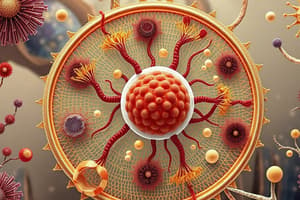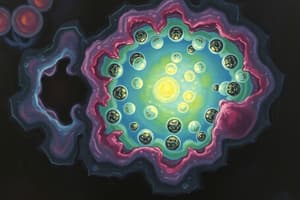Podcast
Questions and Answers
What are the substances that can be impregnated in cell walls?
What are the substances that can be impregnated in cell walls?
- Water, mineral ions, and pectic substances
- Lignin, cutin, and suberin (correct)
- Silicon dioxide, waxes, and cellulose microfibrils
- Proteins, lipids, and carbohydrates
What is the primary role of the nucleus in a cell?
What is the primary role of the nucleus in a cell?
- Providing skeletal support
- Participating in photosynthesis
- Regulating the formation of enzyme molecules (correct)
- Transforming complex organic substances into simpler chemical combinations
What is the primary function of the nucleus?
What is the primary function of the nucleus?
- To transform complex organic substances into simpler chemical combinations
- To provide skeletal support, storage, and protection for the cell
- To regulate the formation of enzyme molecules (correct)
- To participate in photosynthesis
Which organelle is responsible for intracellular nutrition and the hydrolysis of reserve substances?
Which organelle is responsible for intracellular nutrition and the hydrolysis of reserve substances?
Which of the following organelles is involved in the neo-formation of the cell membrane?
Which of the following organelles is involved in the neo-formation of the cell membrane?
What is the function of vacuoles in a plant cell?
What is the function of vacuoles in a plant cell?
What is the function of chondriosomes in cells?
What is the function of chondriosomes in cells?
Which organelle is involved in biosynthesis of galacturonic acids?
Which organelle is involved in biosynthesis of galacturonic acids?
What is the role of plastids in a plant cell?
What is the role of plastids in a plant cell?
What is the function of ribosomes in cells?
What is the function of ribosomes in cells?
What is the function of microvacuoles in a plant cell?
What is the function of microvacuoles in a plant cell?
Which of the following is a characteristic of vacuoles?
Which of the following is a characteristic of vacuoles?
What is the primary function of chondriosomes in a cell?
What is the primary function of chondriosomes in a cell?
What is the function of the tonoplast in cells?
What is the function of the tonoplast in cells?
What is the pH of the vacuolar juice?
What is the pH of the vacuolar juice?
Which organelle is responsible for the synthesis of proteins?
Which organelle is responsible for the synthesis of proteins?
What is the function of aleurone granules in cells?
What is the function of aleurone granules in cells?
What is the role of the tonoplast in a plant cell?
What is the role of the tonoplast in a plant cell?
What is the characteristic of microvacuoles?
What is the characteristic of microvacuoles?
What substances can be found in the vacuolar juice of a plant cell?
What substances can be found in the vacuolar juice of a plant cell?
Flashcards are hidden until you start studying
Study Notes
- Plant cells have cell walls made of cellulose microfibrils, protein microfibrils, pectic substances, water, and mineral ions.
- Cell walls can be impregnated with substances such as lignin, cutin, suberin, waxes, and silicon dioxide.
- Cell walls provide skeletal support, storage, and protection for the cell, and play a role in chemical exchange with the external environment.
- Plasma membranes are semi-permeable and allow the passage of water and some dissolved substances through proper and favored diffusion.
- Active transport of substances through biological membranes requires energy consumption.
- The cytoplasm is a complex mixture of organic and inorganic substances and is the site of many biosynthesis and biodegradation reactions.
- The nucleus is surrounded by a double membrane and contains chromatin, nucleoli, and DNA.
- The nucleus has a primary physiological role in regulating the formation of enzyme molecules, coordinating vital functions, and directing protein synthesis processes.
- Plastids are cell organelles that are involved in photosynthesis and other metabolic processes.
- Plastids include chloroplasts, chromoplasts, and leucoplasts.
- Plastids are organelles found only in plant cells and are of three types: chloroplasts, chromoplasts, and leucoplasts.
- Chloroplasts are the largest organelles and play a crucial role in photosynthesis.
- Chromoplasts are colored and give color to flowers and fruits.
- Leucoplasts are colorless and found in embryonic tissues.
- Mitochondria are oval-shaped organelles that play a fundamental role in cell life by transforming complex organic substances into simpler chemical combinations.
- The endoplasmic reticulum is a network of tubular canaliculi that connect fluid-filled vesicles and different cisterns.
- The Golgi complex participates in the neo-formation of the cell membrane and biosynthesis of galacturonic acids.
- Chondriosomes are the main energy centers of cells and participate in the process of oxidation of metabolites.
- Ribosomes are ultrastructural particles that participate in the process of protein synthesis.
- Lysosomes and vacuoles play a crucial role in intracellular nutrition and the hydrolysis of reserve substances.
- Vacuoles start as small globular shapes in cells and enlarge as the cell matures
- They merge with each other and decrease in number until only one large vacuole remains
- The vacuole is the water reservoir of the cell and contains mineral salts and organic molecules
- The tonoplast delimits the vacuole and allows the passage of water and small-molecule substances
- Organic substances in the vacuolar juice include organic acids, carbohydrates, essential oils, alkaloids, glycosides, and tannins
- The acidic pH of the vacuolar juice differs from the neutral or slightly alkaline pH of the cytoplasm
- During seed maturation, the process of vacuole formation happens in the opposite direction
- Aleurone granules represent the protidic reserves in cells and are consumed by the embryo during seed germination
- The vacuolar juice participates in essential functions in the life of the cell, including hydration, mineral element supply, and retention of toxic substances
- Microvacuoles can only be seen under a microscope after treating the cell with specific vital dyes in dilute solutions.
Studying That Suits You
Use AI to generate personalized quizzes and flashcards to suit your learning preferences.




